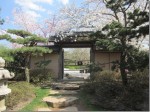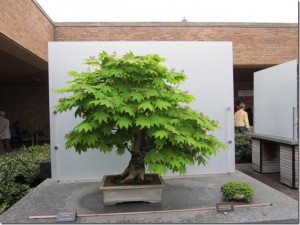In the Tao te Ching, Lao Tzu says:
We pierce doors and windows to make a house;
And it is on these spaces where there is nothing that the usefulness of the house depends.
Therefore just as we take advantage of what is, we should recognize the usefulness of what is not.


Chicago Botanic Garden in Glencoe, IL March 22, 2012
Lunar calendar for Spring
April 2012
4 – Mercury goes direct
6 – Full moon – Good Friday
7 – Passover
8 – Easter
17 – Tax day
21 – New Moon

Feng Shui and Bonsai
For well over twenty years, I have had a love/hate relationship with bonsai. Years ago I purchased nursery stock evergreens intending to bonsai them but for various reason I never got around to it. Totally ignored, they ended up growing into substantially large shrubbery in the yard. Instead I bought a florist’s bonsai tree that needed to be watered daily. I went away for a week, nobody watered it until just before I walked in the door. It was too late. That ended bonsai for a decade or so. In the early feng shui days, I read somewhere that feng shui called bonsai “tortured” plants and “artificial”. This idea seemed somehow wrong to me; however, the lucky bamboo in water (you can leave home for months), money plants, jade plants and Chinese symbolism for plants (see list below) were a good substitute for bonsai at that time.
Several years ago, in my never ending comparing and studying any and all things Asian, I began to see the similarities that bonsai has with feng shui. I joined the Bonsai Society to learn more. The first thing I learned is that very nurturing, kind, dedicated people with great attention to detail and art worked lovingly on their prized possessions. There was no torture involved — just wiring. It is much like dogs being groomed for a dog show. As you watch them, you feel that the dogs, or plants in this case, really loved being so special. The bonsai society members seem to love nature and things growing in the ground and passing on their considerable knowledge to anyone who wants to learn. I highly recommend it.
As we know, Feng Shui means “wind”, water” — two of the five elements (water, wood, fire, earth and metal). Feng shui focuses on our dwelling places and the effect they have on the people who spend time in them and observes all the details and the almost imperceptible nuances that can make a difference in our homes and our lives. To keep this relevant to our current topic — feng shui reveres nature and brings elements of it into homes to balance the seen and unseen energies in our buildings to create harmony between them and create peace and positive energy. Plants are considered the wood element and are a big part of nature. Even before bringing them inside as “house plants” the Chinese began shaping trees into animal shapes for good luck and to ward off evil spirits. These plant manipulations began the bonsai trend.
Bonsai means “tray” “tree” – a tree grown in a small space creating a balanced miniature version of how it would be in nature. The Japanese have developed bonsai to perfection and they are also looking at the almost imperceptible nuances and energies of the trees. For a detailed history of bonsai, take a look at this website: A Detailed History of Bonsai.
Bonsai plants are the epitome of being plants in harmony and balance. Here are a few of the key components in bonsai that I love…
- Bonsai loves things to look old. (Tell that to your mirror)
- Age in plants and people (the ancestors and elderly) is revered and considered to be a very good thing.
- I call the bonsai Masters the “anti plastic surgeons” of the plant world. They are experts at making a young tree look old and interesting and maybe even weathered or gnarled.
- Every bend and scar is nurtured. Idiosyncrasies and imperfections are okay and even appreciated. How great is that?
- Small is good. We have limited space. Large trees are collected from the wild. They are reduced in size and miniaturized. Whole forest scenes can be put in a single pot on the table.
- Every plant scene tells a story.
- Bonsai art follows the same principles of feng shui. Some similarities are:
- Bonsai reveres nature and brings it into our homes and gardens. (Many plants are kept on tables outdoors in the summertime or in the garage in the winter)
- Bonsai follows the same five element theory; water, wood, fire, earth and metal. For example, a water feature is put with the trees (wood)- adding energy.
- Balance and proportion are always a key consideration.
- Focal points are created to draw your eye to where the designer wants you to focus first.
- Sharp angles considered unnatural in nature are avoided. A bonsai arrangement invites the observer to look into the tray and creates a scene much as good feng shui invites you into a home.
- Plants with spikes and thorns are not calming and generally not native to China. (with the recent popularity of succulents and cactus we have to follow the middle path and not reject them all because of a few ‘undesirables’.) Remember to think about the purpose of the plant. Shrubbery can be used as deterrents break ins. For example some edgy holly under a vulnerable window might provide some protection.

*Chinese Significance for some Plants
Bamboo = youth
Narcissus = rejuvenation
Orchid = endurance
Peach = friendship
Pear = longevity
Peony = wealth
Pine = longevity
Plum = beauty & youth
Pomegranate = fertility
Rose = beauty
Tangerine = wealth
Willow = grace
“If you stay open, the plants will teach you.”
Feng Shui Tip for April
Enjoy this early spring in the Midwest. Take your spring cleaning outside and save the house work for a rainy day. Removing dead or remains of living things is always good feng shui and good for the health of the elders living there. Take a walk outside or go to a park or nature center, especially if you don’t have a yard. It will improve your mood and you will come back into your house with renewed energy and a new perspective. Have a great April.
One thought on “Feng Shui Design News for April 2012”